
| - |
Main plants in Japan: Gunma
Main plants overseas: Indiana (USA)
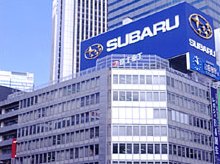
FY2017/18: 1,066,929 units
FY2016/17: 1,064,542 units
FY2015/16: 957,865 units
FY2014/15: 910,695 units
FY2013/14: 825,098 units
FY2012/13: 724,466 units
FY2011/12: 639,862 units
FY2010/11: 656,964 units
FY2009/10: 562,837 units
FY2008/09: 555,333 units
FY2007/08: 596,665 units
FY2006/07: 577,938 units
FY2005/06: 571,375 units
FY2004/05: 581,634 units
FY2003/04: 554,043 units
FY2018/19 sales by model:
Impreza: 321,927 units
WRX: 40,921 units
Levorg: 15,038 units
Legacy: 259,724 units
Forester: 259,697 units
Ascent: 67,177 units
BRZ: 6,913 units
Reference:
https://www.subaru.co.jp/en/ir/library/annual-reports.html
Selling only half a million units of cars every year, Subaru is a small player in the industry. In order to survive it emphasizes on driving dynamics by means of two core technologies - horizontally opposed engines and 4-wheel drive. Today, Subaru is the only car maker producing boxer enignes beside Porsche. No matter whether this kind of engines deliver real benefits, it does give Subaru cars a unique character. As for 4WD, Subaru can claim itself as the King of this technology - even more so than Audi - because 80% of its cars today are equipped with 4WD. Its advantage in 4WD also enabled it to catch the love affair of SUV and crossover easily in the past 2 decades.
However, special technology alone is not enough to keep it independent. Subaru needs a strong strategic partnership to share purchasing costs and increasingly expensive safety / environmental technology. General Motors used to own 20% stakes in FHI. As itself is deep in trouble, most of the stakes have been sold to Toyota. We can expect some joint projects and badge-engineered models produced as a result.
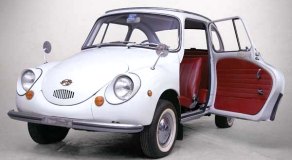 1958 Subaru 360
1958 Subaru 360In the beginning, FHI produced scooters to feed local demand for cheap transportation. As economy improved, it set its sight on car manufacturing. The first mass production car was Subaru 360 of 1958 - note that the "Subaru" trademark was introduced for the first time. It was designed according to the new mini car category that the Japanese government was promoting. This was the first "Kei-car" in Japan, and immediately earned the company a good reputation.
From the very beginning, FHI or Subaru had been showing an innovative engineering approach rarely seen in Japan's motor industry. Its 1965 compact car Subaru 1000 introduced the country's first mass production front-wheel drive as well as a boxer-type 4-cylinder engine. Subaru chose this configuration over conventional transverse inline-4 because its symetrical layout enabled equal-length half shafts, thus avoid the unbalanced steering seen in many of its counterparts.
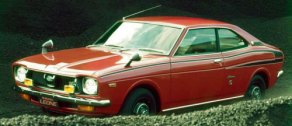 1972 Leone Coupe
1972 Leone CoupeIn 1972, the company made another first by introducing 4-wheel drive into its new Leone (successor to 1000). Again, it employed the trademark boxer engine. From then to the early 1990s, the three generations of Leone became the core model of Subaru. It was well received in the United States and opened the gate for export. The same mechanical format was carried over to Legacy (1989) and Impreza (1993). Now the combination of boxer engine and 4WD had become the trademark of Subaru.
To promote its 4WD technology and dynamic image, Subaru employed British racing team Prodrive to develop its turbocharged Impreza WRX into a rally car. This effort paid off when it won WRC manufacturer championsihp from 1995-97. In the road car side, WRX ignited a long-lasting battle with Mitsubishi Lancer Evolution, together they pushed the Japanese road car technology beyond the reach of European !
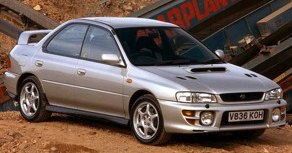 1993 Impreza WRX
1993 Impreza WRXEarlier in the mid-1980s, Subaru spent a lot of effort to develop ECVT (Electronic-controlled Continuous Variable Transmission) based on the design by Van Doorne of Holland. It was applied to the Justy supermini from 1987 and then to its Kei cars. However, feeling ECVT did not suit its driver-oriented Impreza and Legacy, Subaru stopped developing it, letting Honda and Nissan to take the lead in this technology. After all, the small car maker should spend its R&D budget wisely.
By 1990, Subaru had completed its 3-tier platforms - Kei-car platform, compact car platform (Impreza) and mid-size car platform (Legacy). Its attempt in the coupe segment was not too successful with the 1985 XT and 1991 SVX, although both had striking designs. Thereafter, it tried to grow sales by taking advantage of the SUV fever. From the Legacy platform, it created Outback (i.e. basically a jacked-up Legacy wagon) and Forester. The latter was seen as the first crossover between station wagon and SUV. These efforts secured its growth especially in the USA market.
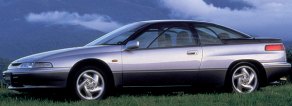 1991 SVX
1991 SVXIn the corporate side, FHI used to be a close partner with Nissan from as early as 1968. When the latter was acquired by Renault, its 20% stakes in Fuji were sold to General Motors. However, the unique boxer engine and 4WD layout prevent further collaboration between the model programs of the two companys. Apart from badge-engineered Impreza as Saab 9-2X for sale in the US market, not much had been done. In 2005, GM sold off its stakes as its own finance worsened. Most of the stakes went to Toyota.